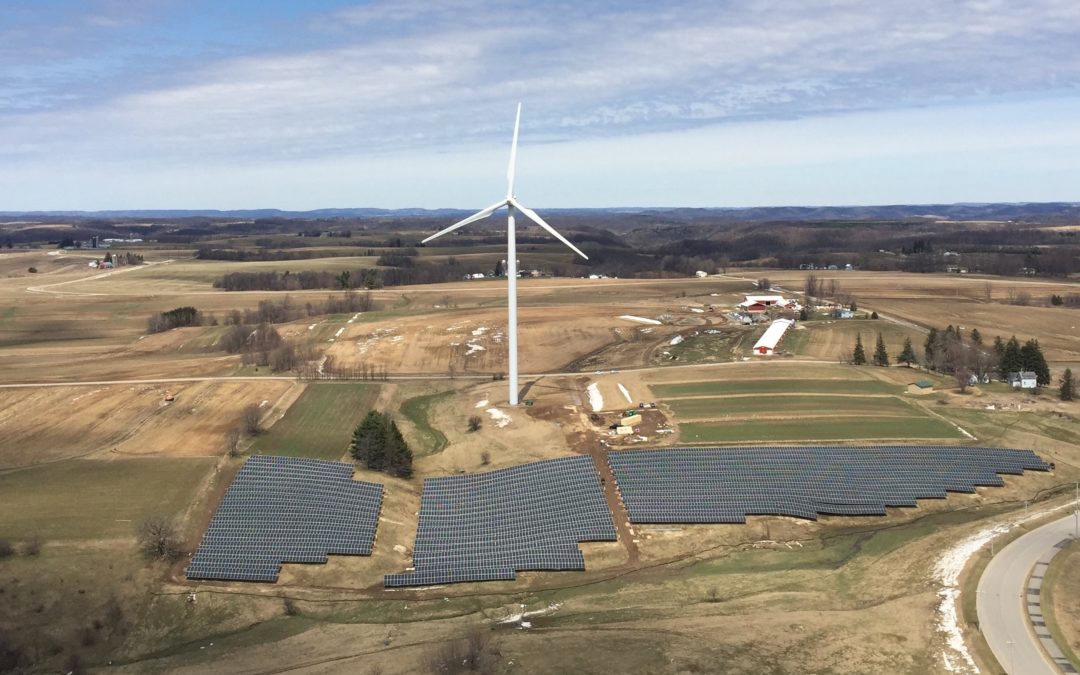
by Michael Vickerman | Jan 13, 2020 | Community, Events, RENEW Wisconsin, Renewables, Solar
At its ninth annual Renewable Energy Summit, set for Thursday January 16, 2020, RENEW Wisconsin will recognize individuals and organizations who have made significant and lasting advances in renewable energy development here in Wisconsin.
Titled “2020 Vision: The Path to 100% Clean Energy,” RENEW Wisconsin’s Summit will take place at Monona Terrace in Madison. Registration starts at 7:00 AM, with entry-level sessions on renewable energy and the electric grid at 7:30am. The main program runs from 8:30 AM to 3:30 PM. The recognition ceremony will begin at 12:45 PM. (Link to Renewable Energy Summit)
At this year’s Summit, RENEW will present five awards to renewable energy champions, developers and businesses for their leadership and accomplishments in 2019. The awards have been grouped under four categories which are listed below. They are:
- RENEWABLE ENERGY PIONEERS OF THE YEAR
- Madison Gas and Electric
- City of Middleton
- Middleton-Cross Plains Area School District
- RENEWABLE ENERGY BUSINESS OF THE YEAR
- Carlson Electric, Hayward
- RENEWABLE ENERGY CATALYSTS OF THE YEAR
- Bjorn Thompson and Jon McCarthy, Attic Angels, Madison
- Sister Rose Jochmann, Sisters of St. Francis of the Holy Cross, Green Bay
- RENEWABLE ENERGY PROJECT OF THE YEAR
- Butter Solar
- OneEnergy Renewables (developer)
- BluEarth Renewables (owner/operator)
- 10 municipal electric utilities (power purchasers)
- Organic Valley (Renewable Energy Credit purchaser)
- City of Madison (Renewable Energy Credit purchaser)
RENEWABLE ENERGY PIONEERS OF THE YEAR
This voluntary initiative, which will result in 1.5 MWAC of new solar power, involves many “firsts.” In 2017, Madison Gas and Electric (MGE) became the first electric utility in Wisconsin to launch a voluntary service that supplies electricity generated from a new solar power plant to retail customers. In 2019, MGE received approval for its first two contracts sleeved through its Renewable Energy Rider service. Ground has now been broken on an array near Middleton’s airport that will supply solar power over a 30-year period to two pioneering MGE customers, Middleton-Cross Plains Area School District and the City of Middleton. When MGE’s array is energized later this year, these utility customers will become the first in Wisconsin to receive solar power under this novel structure.
RENEWABLE ENERGY BUSINESS OF THE YEAR
A family-owned business since 1977, Hayward-based Carlson Electric has emerged as a leading solar energy contractor serving much of northern Wisconsin. In recent years, Carlson Electric has demonstrated considerable skill in financing and designing solar systems for nonprofit groups and civic entities. Indeed, Carlson’s ability to access funds through the Solar for Good program, PACE financing, and Wisconsin Energy Innovation grants was a critical factor in helping such customers as Solon Springs School District, Spooner Ice Arena, Burnett County Humane Society, and Northland Lutheran High School invest in solar power in 2019. Carlson is well on its way to completing the state’s most expansive solar initiative aimed at low- and moderate-income households. By this time next year, Carlson will have financed and installed 269 kilowatts of rooftop solar capacity directly serving 108 apartment dwellers in Sawyer County.
RENEWABLE ENERGY CATALYSTS OF THE YEAR
(1) In 2014, the Sisters of St. Francis of the Holy Cross, located in Green Bay, commissioned the installation of a 112-kW ground-mounted solar array to power the premises and serve as an outdoor classroom on clean energy. Working with the same local contractor (Eland Electric), the Sisters of St. Francis added a 98 kW array next to the existing one in 2019. The result is an inspiring and artfully arranged landscape that combines the ethic of planetary stewardship with the beauty of solar power. The leadership and guidance provided by Sister Rose Jochmann, chair of the community’s sustainability committee, was critical to the ultimate success of this initiative. In her own words: “In 2014, we had hoped to generate half of our electricity from solar but could afford only one-third. Our commitment to sustainability and care of the earth compelled us to look at our options again in 2018.”
(2) Located in Madison’s west side, Attic Angel Community is a senior living campus whose residents include many talented and dedicated volunteers. Last year, Attic Angels contracted with Pewaukee-based SunVest Solar to install PV panels on two apartment wings, totaling 98 kW. That first taste of solar power opened the door to a larger effort initiated by two volunteers living in the Attic Angels Prairie Point community, Bjorn Thompson and Jon McCarthy. Thompson and McCarthy have served on the community’s sustainability committee. Working with SunVest, they designed an offering—effectively a solar group buy—which they presented to their Prairie Point neighbors in hopes that they would take part. Of the 123 households living in Prairie Point, 40 signed up to host solar panels on their roofs, resulting in a total of 133 kW. With that initiative, combined with a 135 kW array installed in 2019 on the roof of Attic Angels’ memory care unit, the campus now hosts 366 kW of rooftop solar capacity, the largest serving a senior housing community in Wisconsin.
RENEWABLE ENERGY PROJECT OF THE YEAR
Butter Solar consists of 10 PV arrays in three states totaling 22.9 MWAC, including seven scattered across western Wisconsin with a total capacity of 17 MWAC. Taken together, the seven arrays constituted the largest addition to Wisconsin’ electric generating fleet in 2019.
From a contractual perspective, Butter Solar may be the most creative solar project in the country. Owned and operated by BluEarth Renewables, Butter Solar’s Wisconsin portfolio supplies low-cost power to the municipal utilities serving Arcadia, Argyle, Cashton, Cumberland, Elroy, Fennimore, and New Lisbon. The villages of La Farge, Viola, and Merrillan are also Butter Solar participants. The same project also generates Renewable Energy Credits for Organic Valley and the City of Madison, helping them meet their ambitious renewable energy goals.
Seattle-based developer OneEnergy Renewables, through their local Madison office, created the complex financing structure that allowed these entities to pool their resources into the project and receive value from it in return. OneEnergy also designed the arrays to blend in with the rural landscape while promoting wildlife and pollinator species. Wisconsin contractors such as Arch Electric contributed by providing expertise and high-quality workmanship.
This year’s summit program will also draw attention to other milestones and notable achievements in 2019, including the following:
- The Public Service Commission approved three large projects that will add 550 MW of solar power in the state by 2021, effectively quadrupling current levels.
- Grant County approved a 21- to 24-turbine wind project proposed by Minnesota-based Project Resources Corporation. Red Barn is the first project to be granted a permit by a local government under Wisconsin’s wind siting rule (PSC 128).
- At its Yahara landfill, Dane County completed the first project in the nation capable of receiving biogas from multiple off-site locations and injecting the cleaned-up methane into a pipeline network that serves CNG gas stations locally and across the nation.
- RENEW and Wisconsin Clean Cities team up to co-host “The Future of Transportation Day” at the State Capitol. The event engages visitors to see how vehicle technology is shaping the transportation landscape, and provided opportunities for test-driving the electric, hybrid and alternative fuel vehicles displayed outside.
- OneEnergy and Arch Electric designed and built a 1 MW array in Ashland, the third shared solar project for Xcel Energy’s Renewable*Connect program.
- Seven residential group solar purchase programs across Wisconsin accounted for 310 installations totaling 1,983 kW of new solar capacity. Both numbers represent all-time highs.
- Central Storage & Warehouse and SunPeak teamed up to install a 654 kW rooftop PV system on a third CS&W property, this one in Caledonia. With more than 2 MW powering its operations, CS&W is the second largest solar host in Wisconsin.
- Adding 230 kW of PV generation atop its parking canopies, Appleton International Airport (ATW) now has more than 500 kW of solar powering its operations, the most at any Wisconsin airport.
- RENEW’s Solar for Good program provides grants that, in 2019, leveraged the installation of more than one megawatt of solar capacity serving 27 nonprofit-owned sites across the state.
Click here for more information on the 2020 Summit program agenda, speakers, and registration.
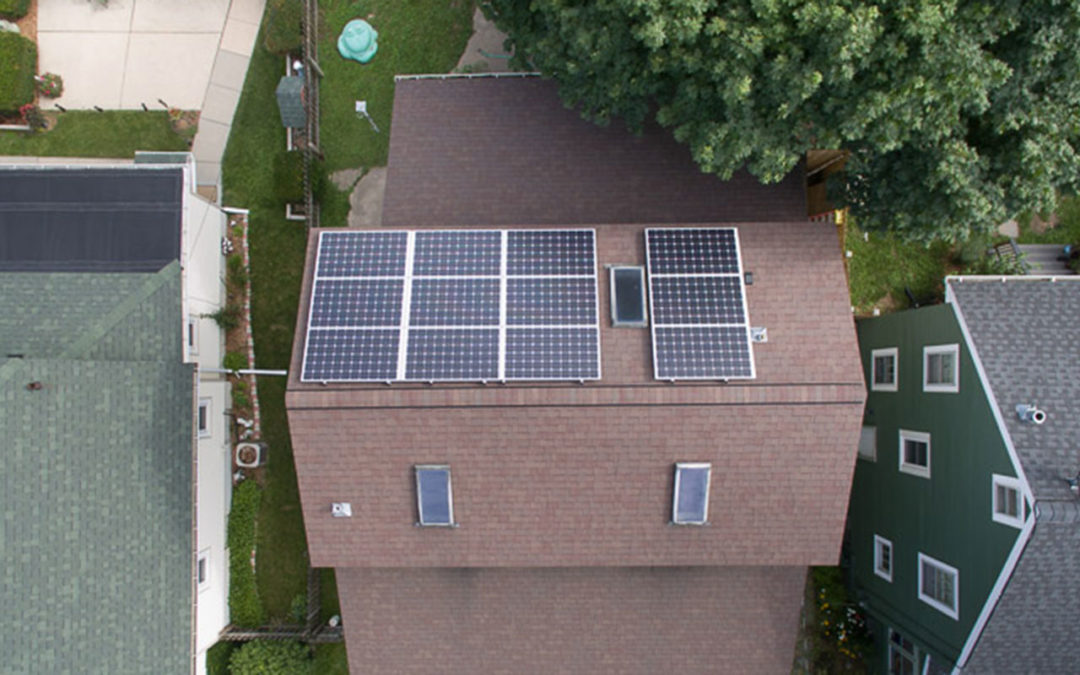
by Tyler Huebner | Jan 8, 2020 | Focus on Energy, Renewables, Solar
The Focus on Energy Renewable Energy Program had another very solid year in 2019. Late last year, the PSC approved several substantive changes in program offerings that will affect the renewable energy industry and its customers going forward. Renewable energy businesses and their customers need to learn about these changes.
First, let’s see how 2019 fared!
Focus on Energy Renewable Energy Program – 2019 Results
For non-residential customers, incentive totals declined slightly in 2019, but substantially fewer PV projects received funding: 135 in 2019 compared with 220 in 2018. At the same time, the average system size increased to 75 kW, up from 48 KW a year ago.Nearly the same number of homes received incentives in each of the past two years – 768 in 2019 compared with 750 in 2018. But more dollars were allocated in 2019 (up from $1.2 million in 2018), because system sizes were larger (7.2 KW in 2019 vs. 6.2 KW in 2018).
Geothermal continued a strong showing, with 77 total installations in 2019, compared with 68 in 2019. In addition, a small wind project received funding in 2019. No biogas projects were funded in 2019.
Changes to the Focus on Energy Renewable Energy Program for 2020
The Focus on Energy renewable energy program will undergo several important changes in 2020 – partly as a result of the trends seen in 2019. Throughout November and December 2019, the Public Service Commission voted to approve these changes, which Aptim, the Focus on Energy administrator, implemented on January 1, 2020.
First, Focus incentives for solar electric (photovoltaic or PV) projects will undergo the biggest change. In a move that many of our members desired to improve their sales cycle, Focus will be changing to “first-come, first-serve” prescriptive incentives for ALL solar PV projects starting in 2020.
However, as demand is expected to remain strong, the elimination of the competitive incentive program for larger PV projects means that fewer dollars will be available for individual projects. This is especially true for larger PV systems. Whereas a customer in 2019 could apply for a maximum incentive of $400,000 through the competitive program, this year the maximum incentive is set at $60,000.
The rationale for this change is to spread available funding across more solar PV projects and incentivize smaller PV projects. We had members with a multitude of opinions on this change, but this is what the PSC and Aptim, respectfully, have landed on.
The tables below shows the 2020 Solar PV incentive levels.
Residential Customer Solar PV Incentives
Business Customer Solar PV Incentives
At the bottom of this post, I’ve included a number of additional details about the 2020 solar program. You can learn more about 2020’s solar program at https://focusonenergy.com/residential#program-renewable-energy
Second, the competitive (RECIP) program will continue for other types of renewable energy projects, such as biogas, small wind, solar thermal, or biomass technologies. The hope is that by taking solar PV out of that competitive program, other technologies may have a better chance of getting funded.
Third, geothermal technologies will be moving out of the Renewable Energy Program in 2020. Residential geothermal incentives will be $750, and information can, for now, still be found under the residential renewable energy page. For buildings (i.e. “non-residential”) installations, geothermal will be treated like any “custom” energy efficiency measure.
Fourth, for Biogas there will still be grants available to conduct Biogas Feasibility Studies in amounts up to $15,000. In addition, biogas projects can compete in the RECIP competitive grant process. You can learn more about these opportunities at https://focusonenergy.com/business/renewables.
Here are additional details on the Focus on Energy Solar PV Program for 2020. These details were provided by Focus on Energy in late 2019 via email to their renewable energy trade allies.
Summary of Renewable Rewards updates for 2020
- The Rural portion of the program will be for residential customers and Agricultural Producers.
-
-
- Residential Rural customers will get up to a $500 bonus for installing a system. Bonus can’t be larger than prescriptive incentive. It will be equal to the incentive amount or $500, whichever is smaller.
- Agricultural Producers (Business customers) will qualify for an incentive match up to $10,000.
- Agricultural Producers are defined as “businesses engaged in the production of grain, livestock, milk, poultry, fruits, vegetables, bees and honey; fish; shellfish; or other common agricultural products including greenhouses.
- A Reservation system will be put in place for all projects.
-
- Residential customer projects will have three (3) months to complete.
- Business customer projects will have six (6) months to complete.
- There will not be a down payment requirement to reserve funding.
- Projects without a proposed completion date will be moved to the back of the queue.
- Reservation form will be posted on the website on January 3, 2020.
- All Reservations and Applications will be done online. If a customer or Trade Ally is unable to use an online version, the Program will provide them with a PDF version upon request, but it will not be available on the website.
- Azimuth rules: All projects within 90 degrees of due South (Compass Direction of 90 to 270 degrees) will be eligible for incentives and will receive the same incentive amount, regardless of azimuth.
- Projects completed in 2019 will get the 2019 incentive rate (will have 60 days from completion date to submit application).
- Projects completed in 2019 will receive the 2019 incentive rate (will have 60 days from completion date to submit application).
- Residential projects that began construction prior to November 1, 2019, and will complete before January 31, 2020 will be eligible for the 2019 incentive rate.
- Commercial projects that began construction, signed contracts, or signed purchase orders prior to November 1, 2019, but will not complete until 2020, will be eligible for the 2019 incentive rate only (12% of project cost, up to $4,000)
- Projects that sign contracts or purchase orders after November 1, 2019, and complete in 2020, will be eligible for the 2020 incentive rate.
- The total budget for Renewable Rewards is set at $4,000,000. The budget will be divided between the following customer groups and project sizes:
-
-
- Remaining funding will be posted on the website and updated every two weeks.
- For business customers: if funding in one tier is exhausted, the customer will have the option to reserve funding for the maximum amount in a smaller tier, provided funding is still available.
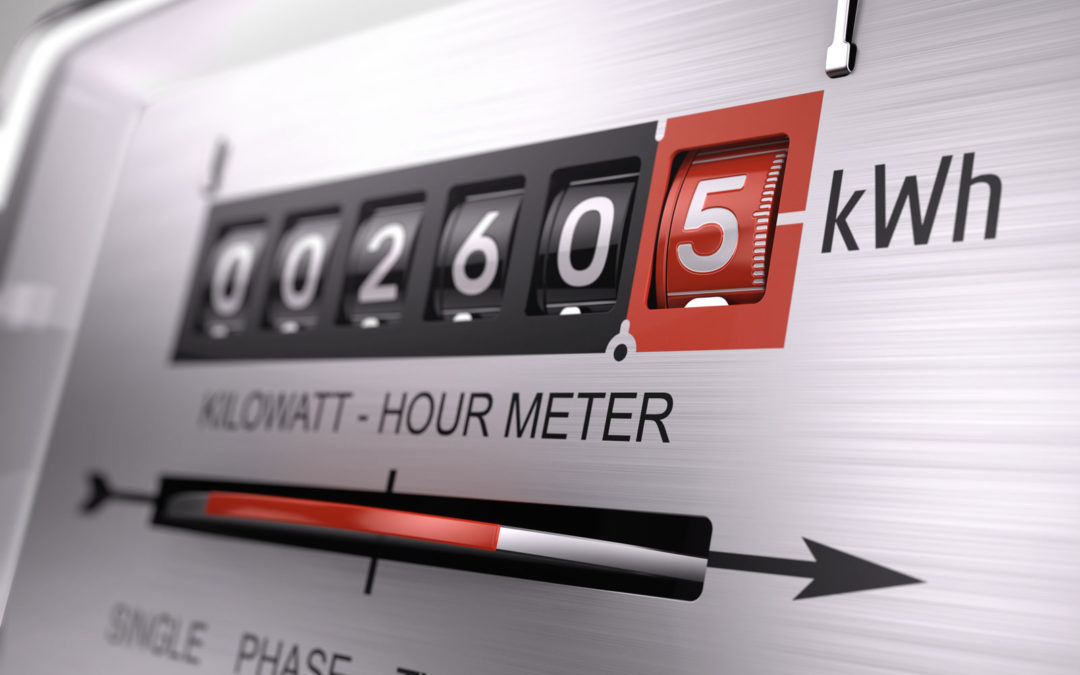
by Tyler Huebner | Jan 7, 2020 | Renewables, Solar, Utilities
Our goal is to streamline the process for renewable energy installations and utility reviews.
Over the past two years, RENEW Wisconsin has been actively working as a member of the Wisconsin Distributed Resources Collaborative (WIDRC) to modernize and improve the necessary forms for applying to install a new distributed generation (DG) system in Wisconsin.
We are excited to help spread the word that as of January 1, 2020, the new forms are available and recommended for use!
These forms represent one of the first formal steps in the process of getting approval to install a new distributed generation system in Wisconsin. Distributed generation systems include solar electric (photovoltaic), small wind, battery energy storage, biogas or biomass electric generators, and/or other technologies that fall under Wisconsin Administrative Code Chapter PSC 119.
Access the New Wisconsin DG Application Forms
Distributed generation installers must complete these forms and submit them to their local electric provider to start the process of obtaining the ability to “interconnect” with the local electricity grid.
You can download the new forms here. See the right-hand column “New Wisconsin Interconnection Forms” for the links to each form.
These DG application forms replace the 6027 and 6028 forms and consolidate the information needed into one “base” form, the Wisconsin Standard Distributed Generation Application Form. Then, installers will fill out a more streamlined technology-specific form to provide the information on which type of distributed generation system(s) will be installed.
The forms are fillable in PDF and can be digitally saved to speed up the process. In addition, the forms now clarify that each size category for DG systems is based on AC electricity ratings.
Installers should continue to use the same 6029 (20 kilowatts and under) and 6030 (above 20 kilowatts) Interconnection Agreement forms when the system is ready to be interconnected to the utility.
Reducing Solar “Soft Costs”
Improving these forms is one of many activities we are undertaking to reduce the “soft costs” of installing solar and DG systems in Wisconsin. In particular for solar, where approximately 1,000 systems are now being installed annually in Wisconsin, we’re looking to save time in the permitting, inspection, and interconnection processes. Time saved in each of those processes will add up quickly when installers are doing it one thousand times each year!
To make this happen, Jodi Jean Amble, our Communications & Events Director, spent a lot of hours designing and constructing these new forms to be very user-friendly. We are hopeful these forms will make the DG application process a little bit easier for our members and all the companies that need to use them.
To learn more about this process and update, please check out this letter that was provided to Wisconsin electric utilities and DG installation firms.
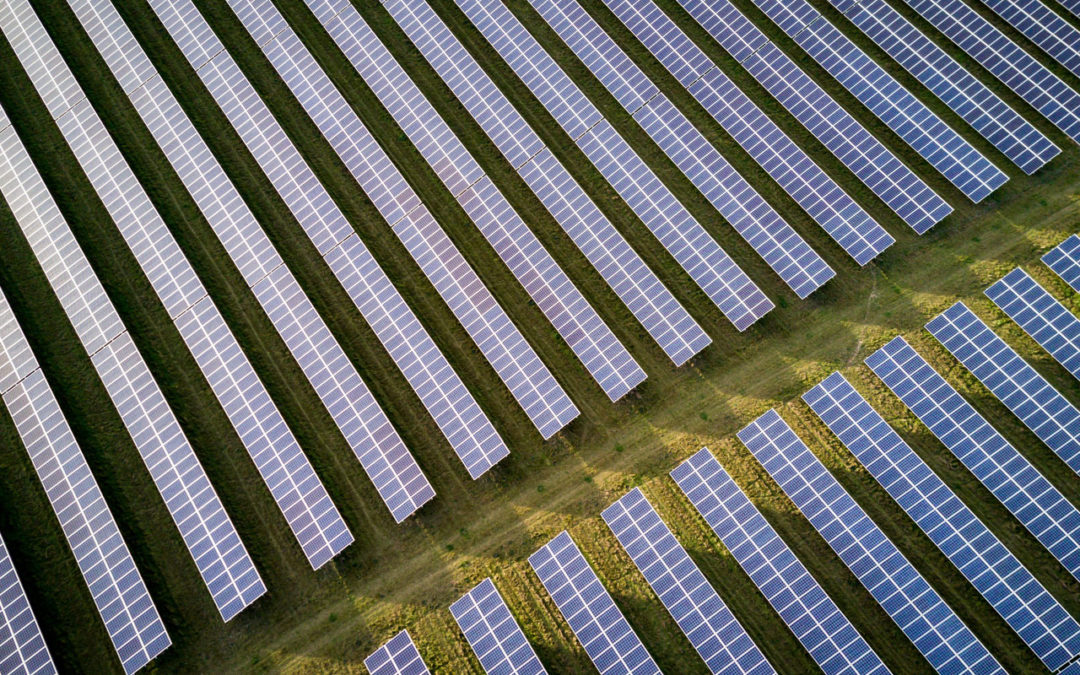
by Tyler Huebner | Dec 19, 2019 | Public Service Commission, Renewables, Solar, Utilities, Utility Scale
Today, the Public Service Commission of Wisconsin approved the Point Beach Solar Farm project!
Point Beach will be a 100 megawatt solar farm, and will supply electricity to WPPI Energy. WPPI is a wholesale energy provider for 41 municipal utilities in Wisconsin plus 10 more across Michigan and Iowa. The developer is NextEra Energy Resources, one of RENEW Wisconsin’s newest Business Members.
Almost three years ago, WPPI Energy made a splash by announcing the results of a request for renewable power proposals. At the time, wind energy was expected to be the winner of that competition. But this solar farm proposal was selected, foreshadowing how cost-effective solar power was becoming in Wisconsin.
Since then, other major power suppliers have followed WPPI Energy’s lead. In April 2019, the PSC approved the Badger Hollow and Two Creeks Solar Farms. Along with the 49.9 megawatt Richland County Solar Farms which was approved at the County level, these projects marked the first utility-scale solar approvals in Wisconsin.
This Point Beach Solar Farm will be placed on ground right around the existing Point Beach Nuclear Energy plant. It will also be located next to the Two Creeks Solar Farm now in construction, with the two projects combining to provide 249 megawatts of solar capacity in Manitowoc County.
With today’s PSC approval in hand, construction will begin next year and it should come online in 2021. It is expected to provide enough energy to serve more than 23,000 people.
Congratulations to NextEra Energy Resources and WPPI Energy on this project approval!

by Tyler Huebner | Nov 1, 2019 | Renewables, Solar, Utilities
Yesterday, Alliant Energy’s Wisconsin Power & Light utility company announced plans to add 1,000 megawatts of solar power by 2023 to provide more clean, renewable energy to their Wisconsin customers.
By our analysis, this commitment to solar power would equate to:
- About 2.7% of Wisconsin’s entire electricity consumption
- Enough electricity to provide the annual needs of about 250,000 Wisconsin residential electric customers
- An estimated $5,000,000 annually in land leases paid to landowners who would lease their land to the solar projects
- $4,000,000 annually provided across the local townships and county governments where the projects are located (if in Wisconsin), allocated through the state’s utility shared revenue formula
- Create about 1,600 jobs during construction
- Currently Wisconsin uses about 9,200,000 acres as farmland and has 34,700,000 total acres of land. The approximately 7,000 acres of solar would sit on just 0.076% of Wisconsin’s farmland and 0.020% of Wisconsin’s total land.
- With appropriate grassland and pollinator-friendly practices, the land under these solar arrays can provide numerous benefits by regenerating soil, supporting pollinators like bees and butterflies, and removing carbon from the air and burying it in the soil.
Tyler Huebner, RENEW Wisconsin’s Executive Director, issued the following statement: “This is another important announcement signifying solar power’s time has come in Wisconsin. The costs for solar power have declined about 80% in the past decade, making solar a cost-effective source of electricity for Wisconsin customers.”
Huebner continued: “In addition to utility-scale solar development, RENEW Wisconsin and our members know that solar on homes, buildings, and in our communities also provide tremendous benefits and we look forward to working with Alliant and other utilities to ensure distributed generation and other renewable resources have a fair and equal shot, and receive fair and equal treatment, at providing their benefits as the state continues to shift towards more homegrown, healthy, and smart renewable energy.”
Alliant also announced they will build the first of their “community solar” projects, a program previously approved by the Public Service Commission, in Fond du Lac.
For context, Wisconsin currently has approximately 130 megawatts of solar. In April 2019, approximately 500 megawatts of solar in Wisconsin were approved (450 megawatts were approved by the Public Service Commission and nearly 50 megawatts were approved by the Richland County Board).
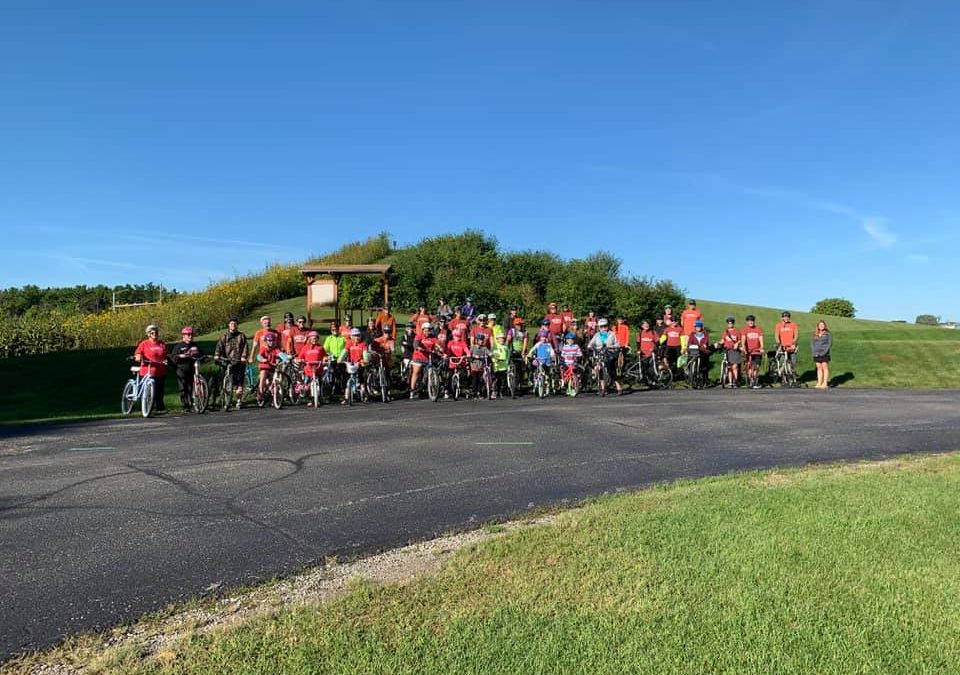
by Tyler Huebner | Sep 30, 2019 | Community, Electric Vehicles, Events, Geothermal, Hydroelectric, RENEW Wisconsin, Renewables, Solar, Wind
On Saturday, September 14th, our 7th Annual “Ride with RENEW” bike ride, held in the Fox Cities this year, was a huge success!
We started the morning at Prairie Hill Park in Grand Chute with 40 determined bike riders and 12 wonderful young ladies from the Girl Scouts of the Northwest Great Lakes! The State Representative for the area, Amanda Stuck, welcomed our riders by talking about the importance of energy, and how easy it has become to take advantage of clean energy sources.
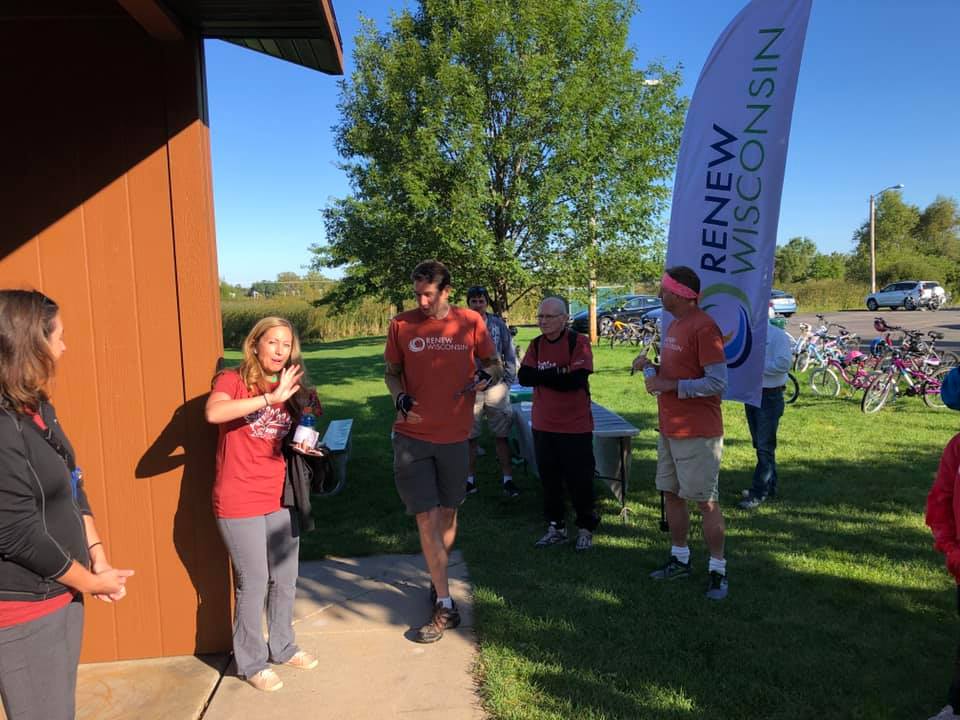
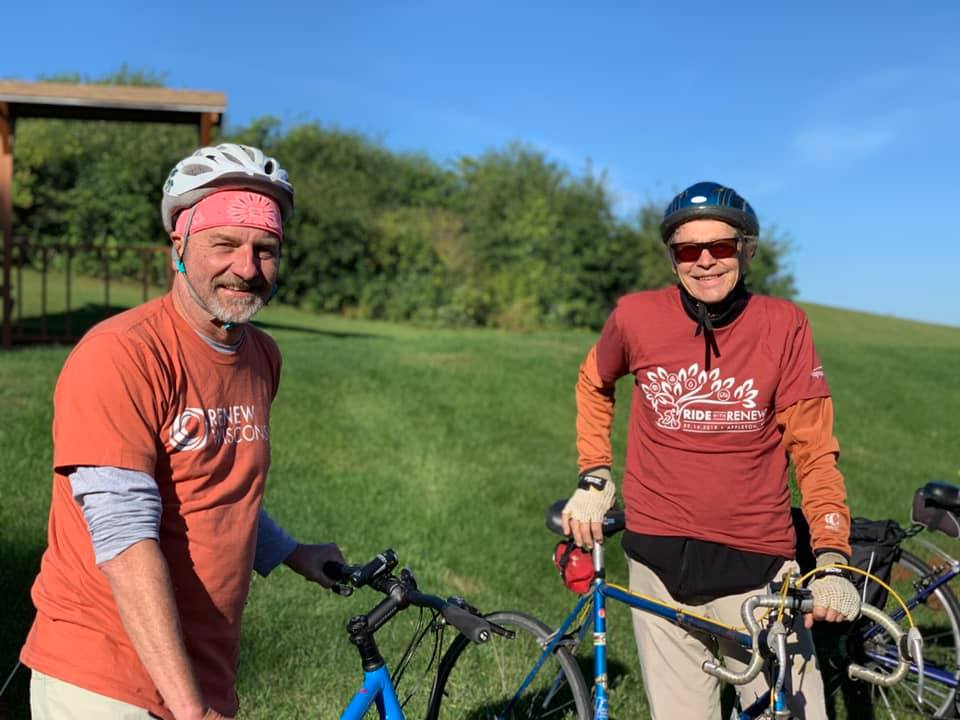
Our bike riders and Girl Scouts then set out for the Bubolz Nature Center where we explored their solar panels and microgrid, built and operated by Faith Technologies, who walked us through this one-of-a-kind facility in Wisconsin. The microgrid includes a lithium battery, a hydrogen fuel cell, and a generator, and the facility runs off the solar panels and renewable storage most of the time.
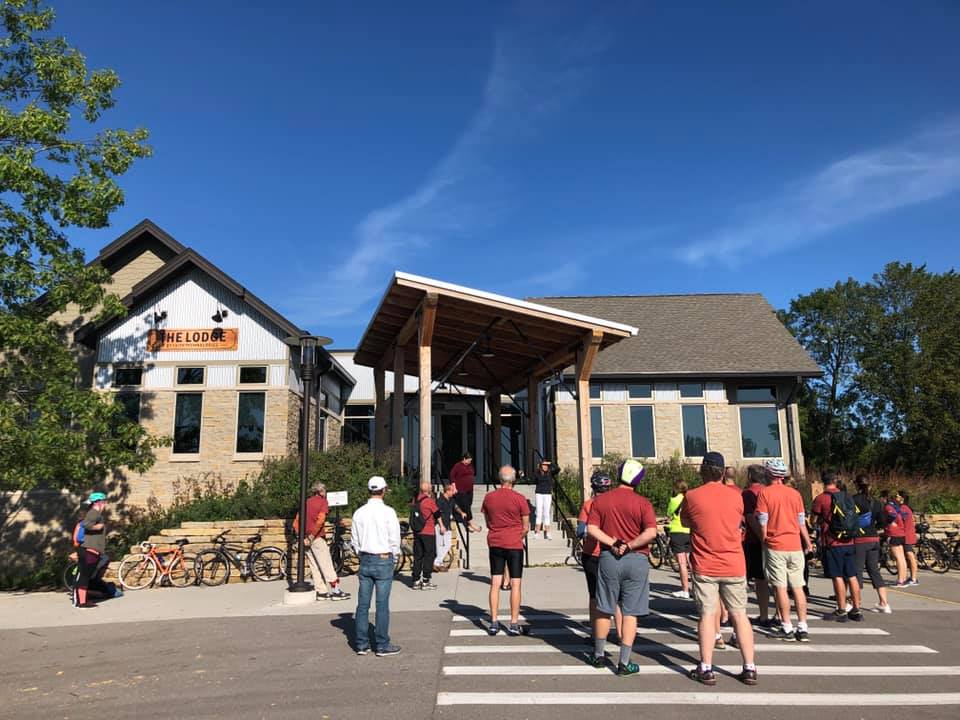
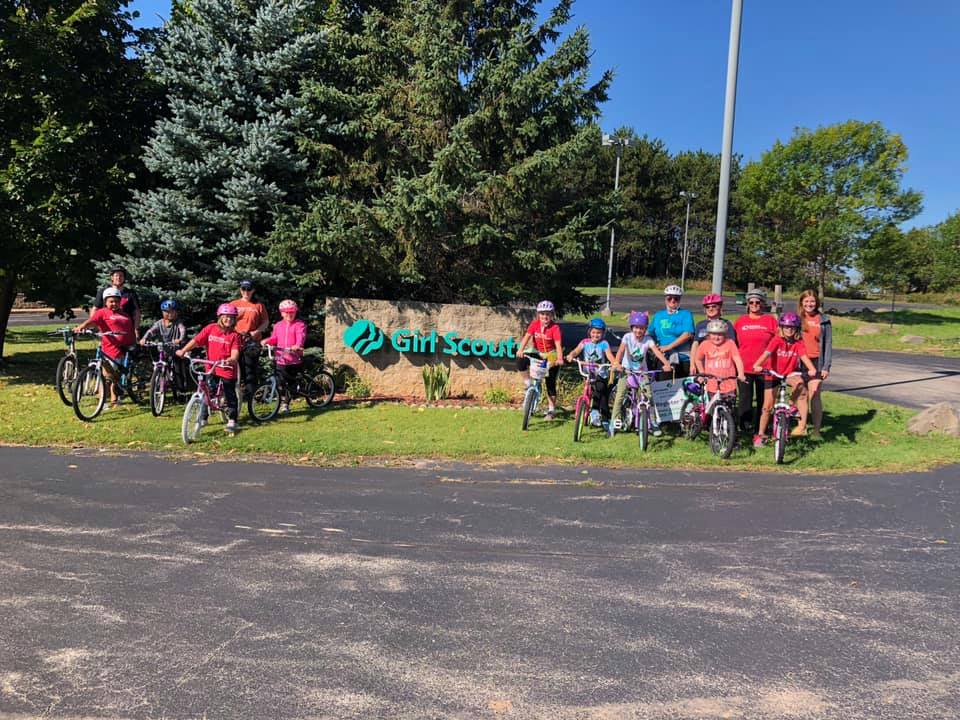
Next we biked 10 miles to Evergreen Credit Union which has become a regional leader in sustainability. With solar panels covering its roof, Roni Kasperek of Evergreen described the credit union’s migration to becoming a clean energy leader and how sustainability is a core value of the organization.
We turned Schildt Park into a clean energy mecca at lunch! Featuring pizza from Glass Nickel Pizza, we were fortunate to have the Ripon Lego League join us as they collected data from our bike riders to help them with their Lego challenge of designing a sustainable community! Our riders engaged in the Lego League’s survey, created to help the kids better understand bikers’ safety needs and how a city could better support bicycling. The Lego League kids did a great job helping to serve lunch and engage with our bikers!
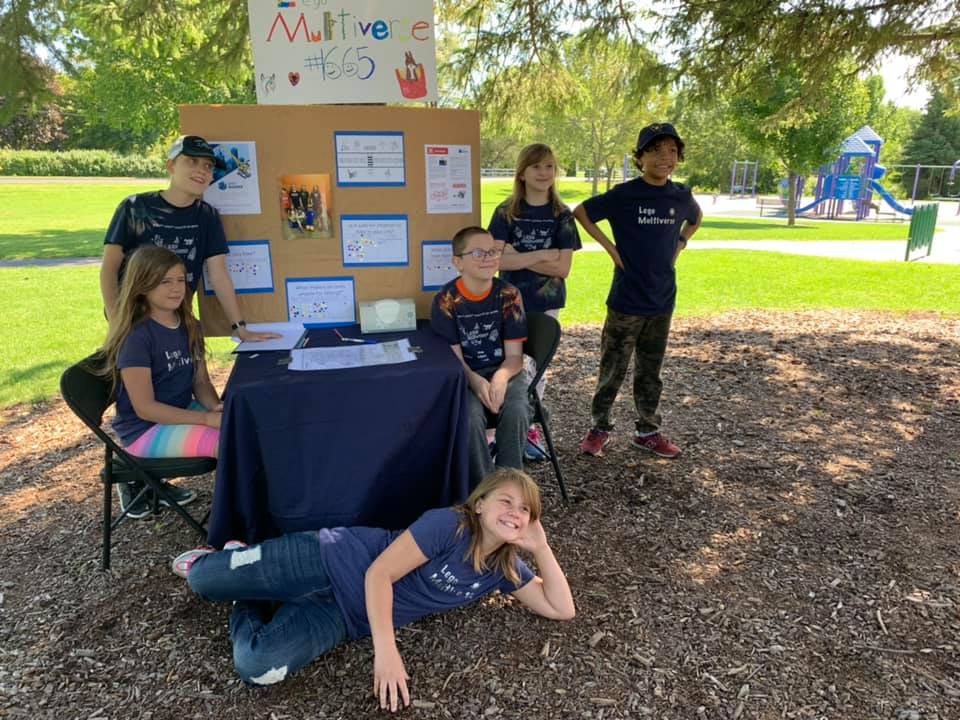
In addition, we had an electric vehicle exposition featuring 9 vehicles from 5 car brands that drive with electricity, instead of gasoline. This technology is advancing and many new types of affordable electric vehicles are coming out soon. We loved showing these cars off to our bike riders and a few members of the public, and the vehicle owners loved chatting about how much they enjoy driving electric.
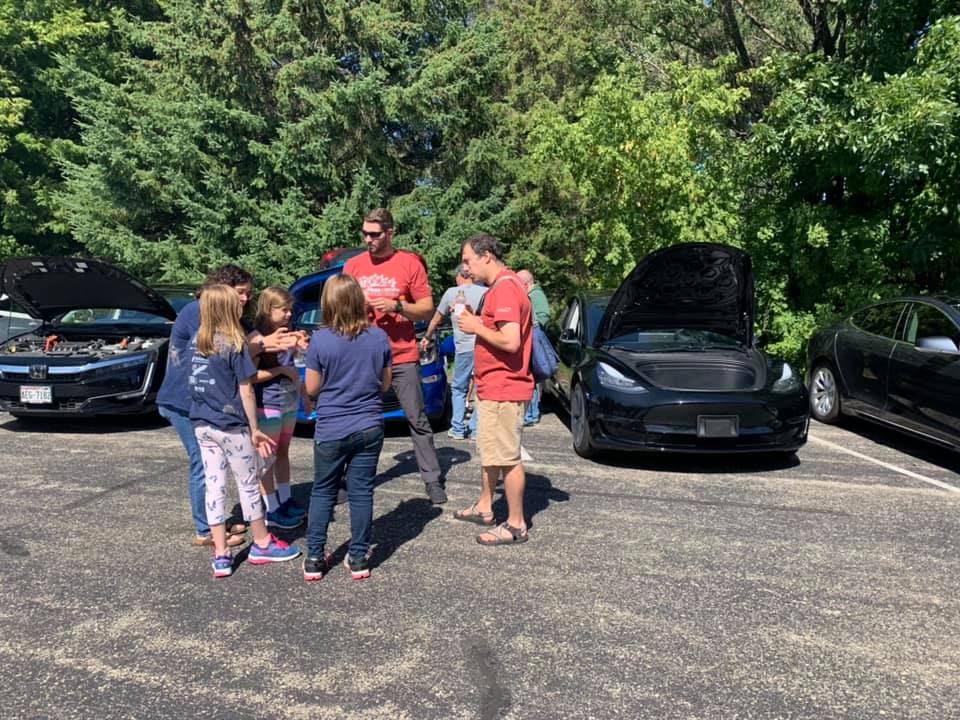
After lunch we saw small wind turbines at Essity (formerly SCA Tissue) right along the bike path. These 4 turbines were designed and installed by a former Wisconsin company called Renewegy (which is unfortunately no longer in business). Next we headed to Heckrodt Wetland Reserve in Menasha where we learned about their tremendous efforts to preserve this part of the state and how solar power is a sustainable part of their growth.
We next saw an innovative solar carport at the Petit and Dommershausen law offices in downtown Menasha, where were treated to a much-needed snack. Then we biked to RiverHeath, which is a new development in Appleton right along the Fox River. Mike Barnett of HGA described an innovative use of geothermal energy, designed by HGA and installed by G.O. Loop, that uses the temperature of the water to provide heating and cooling to the new buildings in the RiverHeath complex.
Last, but certainly not least, we biked to the first power plant in Wisconsin that delivered electricity to a customer. We were greeted by “Thomas Edison,” a generous measure provided by the Appleton Historical Society, who helped explain the origins of the Vulcan Street Hydropower Plant which was put into service in 1882 and provided electricity for lights at paper manufacturing plants as well as one home.
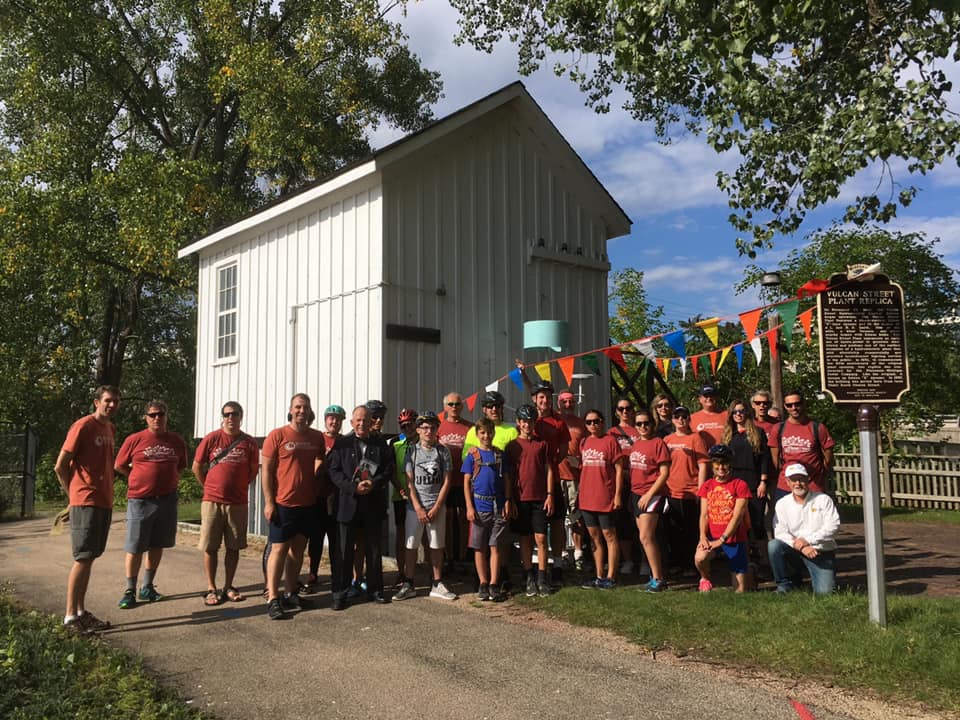
The actual Vulcan plant burned down in 1889. The Appleton Historical Society, as well as Ford Motor Company, contributed many hours and, in Ford’s case, equipment, to allow this replica of the original hydropower plant in Wisconsin to stand and to give visitors like us the opportunity to learn about Wisconsin’s energy history and see it in action.
Finally, we arrived back at Prairie Hill Park, where we enjoyed beer from Central Waters based in Amherst and celebrated a great event with our riders! The weather was outstanding, and we can’t wait to plan next year’s Ride with RENEW.
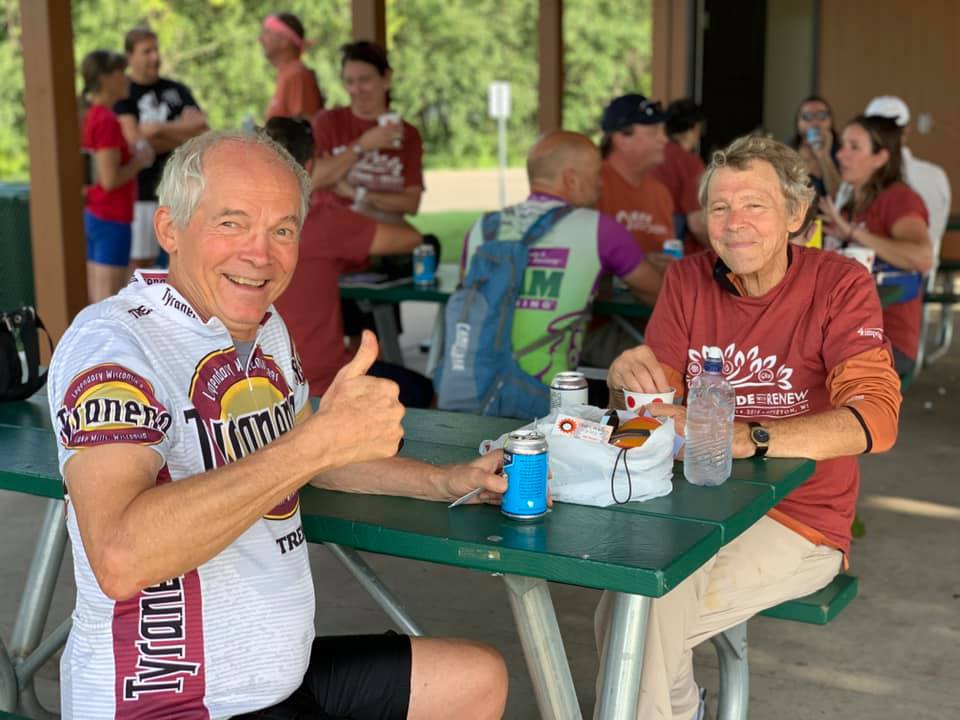
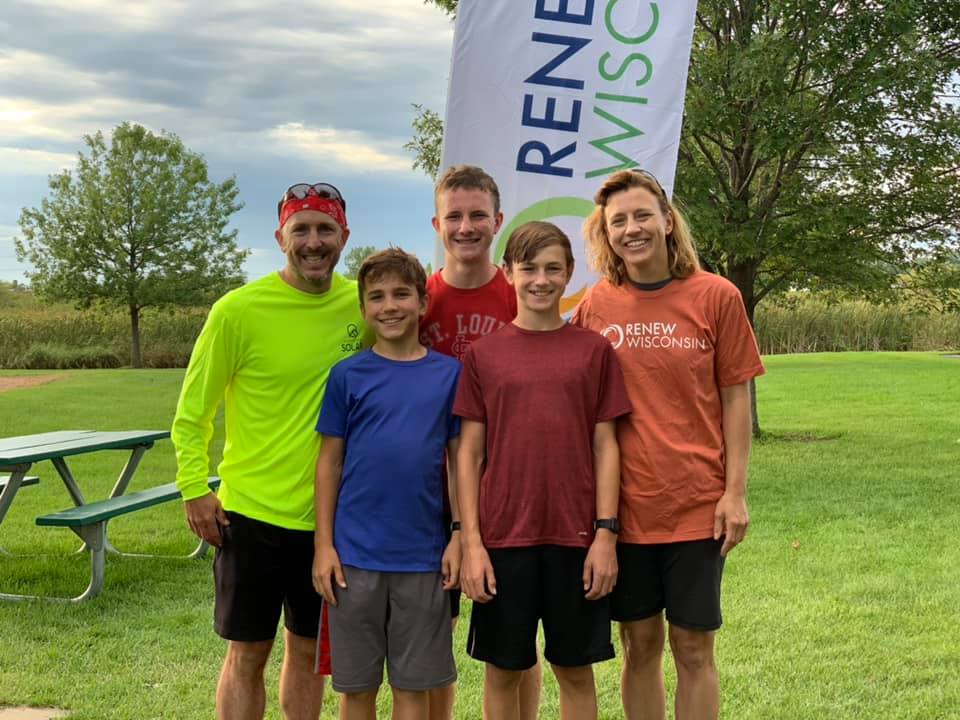
Four of RENEW staff members joined Board member Jim Funk of Energize LLC as he showed off one of Wisconsin’s earliest examples of “bi-facial” solar panels – panels that can receive light from both sides of the panel to create electricity. This installation at a carport has served as a beautiful visual example of solar energy in the Fox Cities since 2010. For example, check out the very cool design when our staff member Jim Boullion’s car was parked underneath the panels.
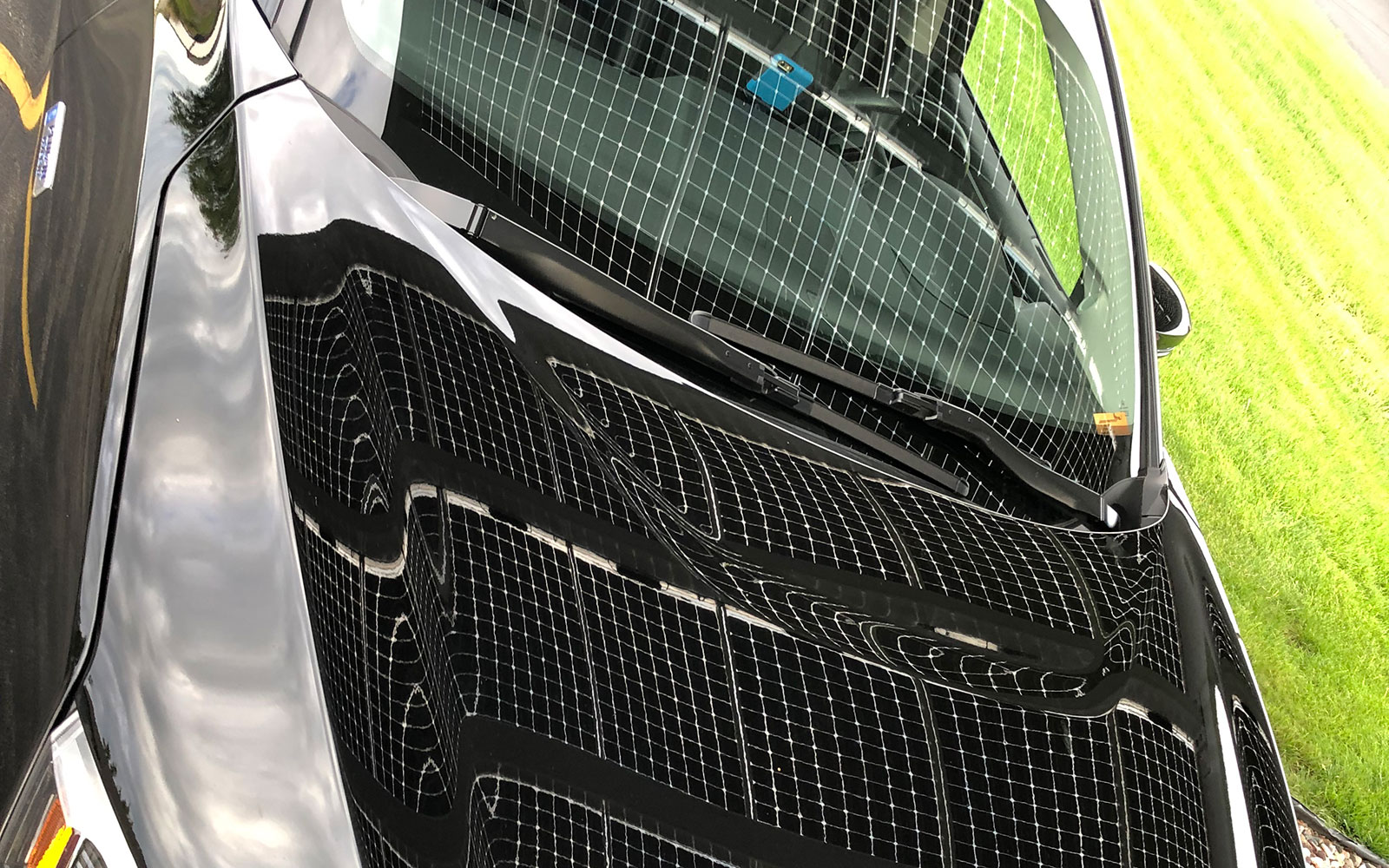
Check out our Facebook photo album to see more images of the ride!
Thank you again to all of our sponsors, shown below, all the bike riders, the Girl Scouts, Lego League, and everyone who donated to support our riders and helped us raise over $17,000 to continue our education, advocacy, and collaboration to advance renewable energy in Wisconsin!
2019 RIDE WITH RENEW SPONSORS















